Key takeaways:
- Aerial photography provides a unique perspective and requires patience, transforming the ordinary into extraordinary experiences.
- Drone mapping enhances understanding of landscapes and improves data collection efficiency, offering new insights into geography and infrastructure.
- Effective aerial photography relies on careful planning, manual camera settings, and thoughtful composition to achieve stunning results.
- Personal experiences highlight the importance of patience in capturing fleeting moments and the stories within landscapes, leading to deeper connections with the environment.
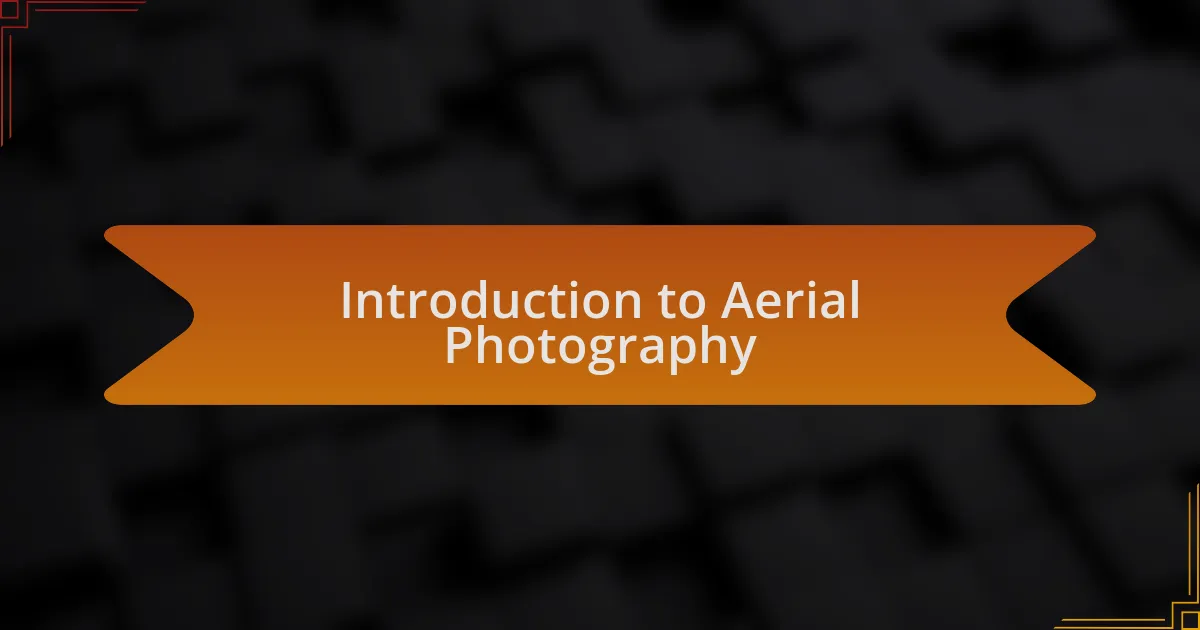
Introduction to Aerial Photography
Aerial photography is more than just capturing stunning images from above; it’s a practice that offers a unique perspective on the world around us. I remember the first time I hovered my drone over Zanzibar’s coastline, how the vibrant blues of the ocean contrasted against the sandy shores. That moment sparked a sense of wonder that made me realize just how much beauty lies hidden from ground level.
As I navigated my drone through the skies, I discovered that aerial photography requires more than technical skill—it demands a deep sense of patience. There were days when the wind would thwart my plans, forcing me to wait for just the right moment to soar above breathtaking landscapes. Have you ever felt that anticipation, waiting for nature to align perfectly with your vision? It’s in these moments of stillness that I learned how patience transforms the ordinary into extraordinary.
Each flight became an exercise in mindfulness, cultivating a deeper connection to the environment. The beauty of capturing a beautiful landscape from up high wasn’t merely in the resulting images but in the journey itself. I learned to appreciate the fleeting moments: the sunlight breaking through the clouds, the waves lapping at the shore, and the intricacies of the terrain below. Through aerial photography, I’ve come to understand that patience is not just a virtue; it’s an essential part of the artistic process.
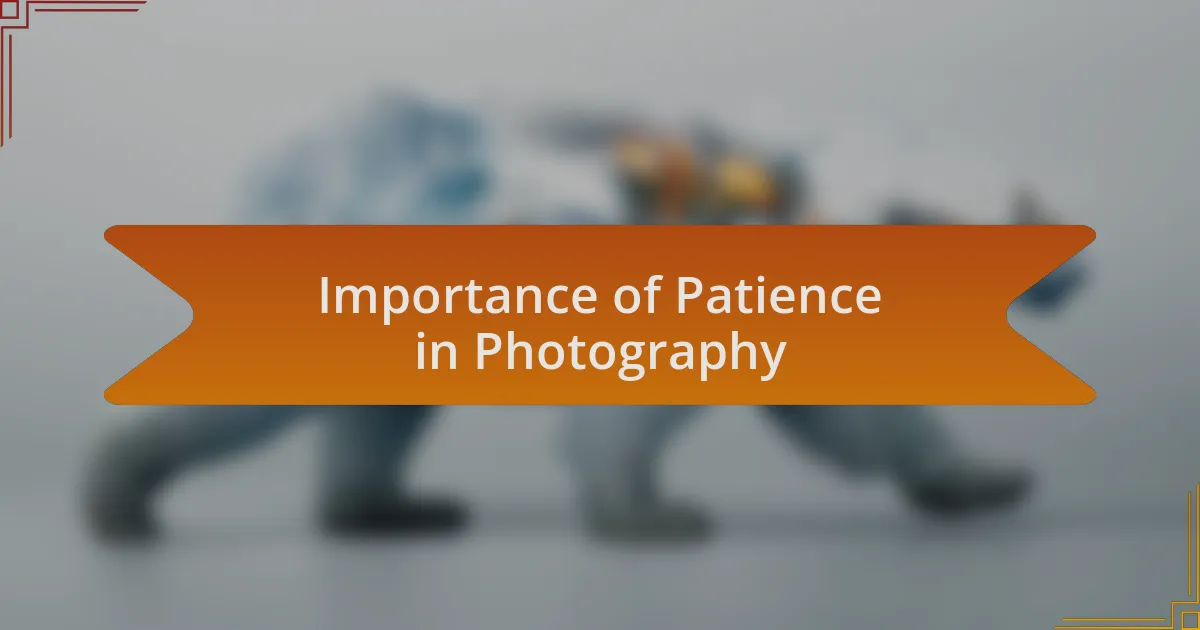
Importance of Patience in Photography
Patience in photography often means waiting for nature to unveil its beauty—something I’ve learned firsthand. On one occasion, I spent hours hovering my drone above the stunning Serengeti landscape, waiting for the right light as the sky shifted colors with the setting sun. It was a lesson in stillness; a mere few moments made all the difference in capturing a breathtaking image.
There were times when the perfect shot seemed just out of reach. I remember one day working with unpredictable weather, where clouds obscured my subject for what felt like ages. I began to understand that those extra moments of waiting weren’t wasted; they were essential. Would I have given up if I didn’t truly grasp the significance of patience in those scenarios? Absolutely, I would have lost out on images that still take my breath away today.
This journey taught me that patience in photography is not just about the wait; it’s about embracing the experience that unfolds. Each second spent in anticipation not only improves the outcome but also deepens my appreciation of the landscape I’m capturing. I now see every flight as a meditation, where patience allows creativity to bloom amidst the constraints of time and nature.
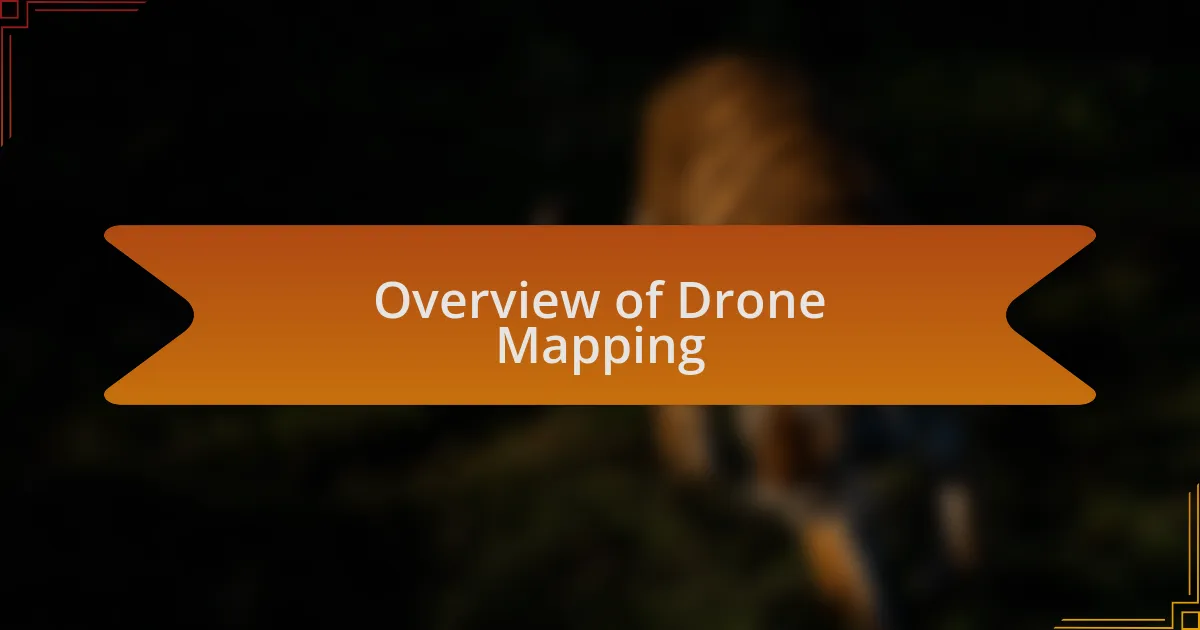
Overview of Drone Mapping
Drone mapping has revolutionized how we perceive and analyze landscapes. By using drones equipped with advanced cameras and sensors, we can create detailed aerial maps that provide insights into geography and infrastructure. This technology not only enhances our understanding of the environment but also allows for efficient data collection that was once time-consuming and labor-intensive.
From my own experiences, I’ve seen how drone mapping can transform a simple project into a multifaceted exploration. I remember a time when I was tasked with mapping a coastal area in Zanzibar for a conservation effort. Soaring above the land, I was struck by the intricate patterns of the shoreline. It was a reminder of how technology aids in appreciating the natural world, as each flight revealed details that are often overlooked from the ground.
The versatility of drone mapping extends beyond just capturing images; it opens up endless possibilities for analysis and decision-making. Whether you’re monitoring agricultural fields or assessing urban development, drones offer a new perspective that fosters a deeper connection with our surroundings. It makes me wonder, how differently would we engage with our world if we embraced these aerial insights more regularly?
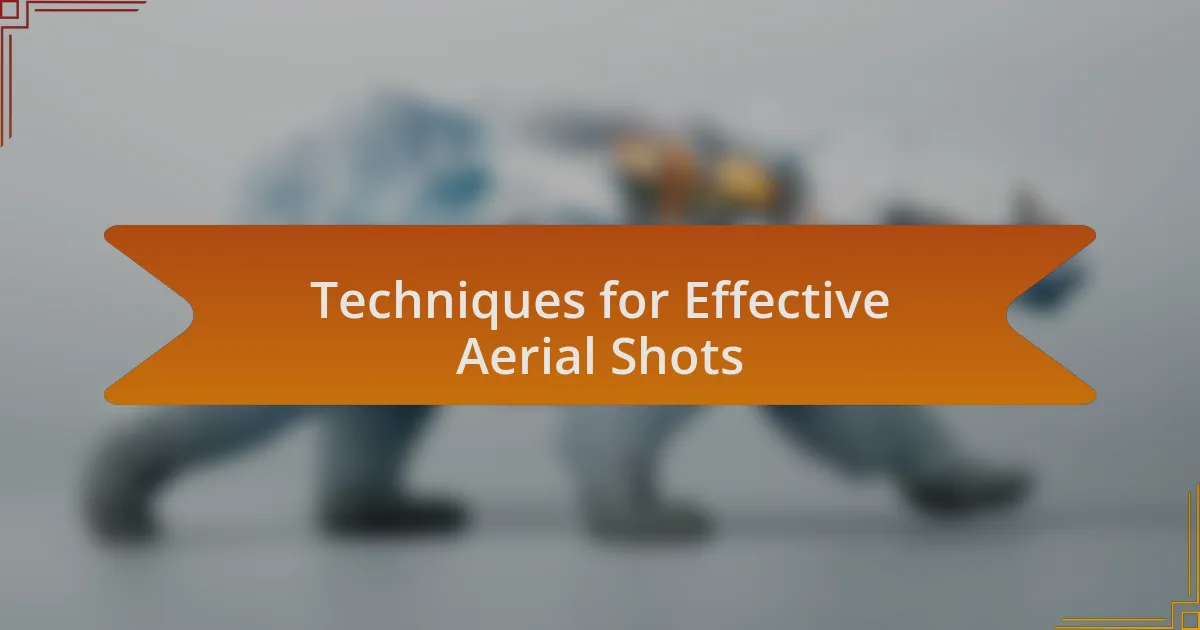
Techniques for Effective Aerial Shots
To achieve effective aerial shots, I’ve learned that planning is essential. When I approach a shoot, I spend time mapping out my flight path and considering the time of day for optimal lighting. I’ve flown in the early morning hours when the sun casts a warm hue over landscapes, and it felt like I was capturing magic unfolding beneath me.
Another technique that has greatly improved my aerial photography is utilizing manual settings on the drone’s camera. I remember wrestling with auto settings during one of my first flights; the results were disappointing. Once I learned to adjust the aperture and shutter speed manually, my images transformed. The colors became more vibrant, and the details sharper. It was incredibly rewarding to see the difference my decisions made.
Lastly, I always focus on the composition while capturing shots from above. Choosing angles that highlight the unique features of the landscape is crucial. I often find myself circling an area, searching for that perfect perspective. It’s like a treasure hunt, and when I finally line up the shot just right, there’s a rush of excitement. Have you ever experienced that thrill of discovery when capturing something beautiful from above? It’s a feeling that keeps me coming back for more.
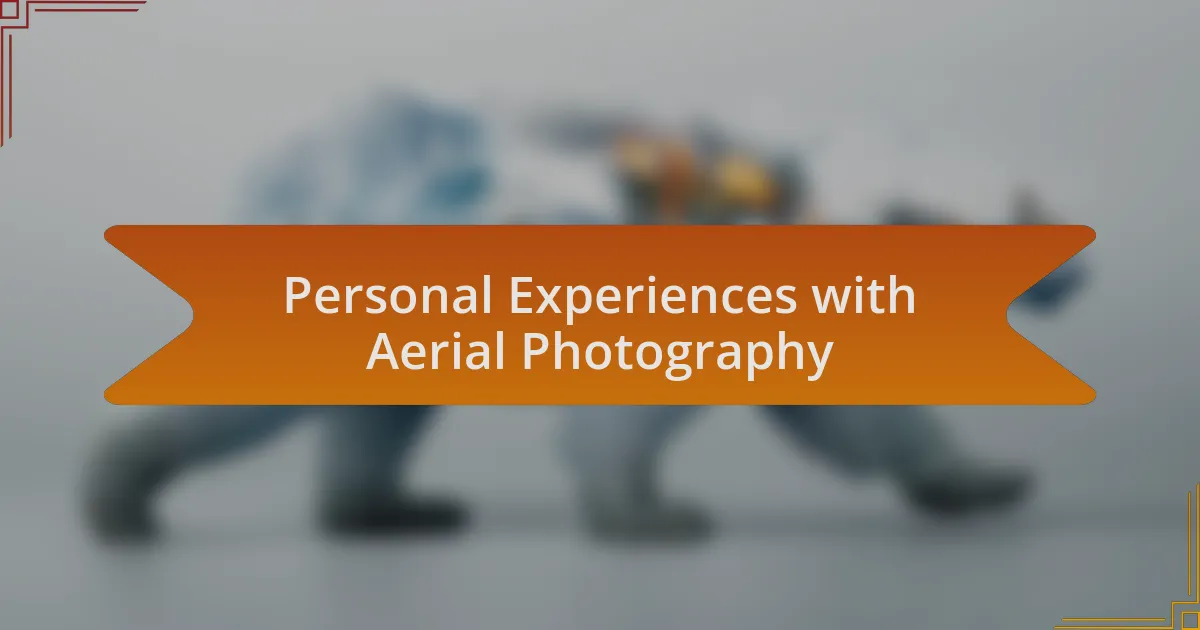
Personal Experiences with Aerial Photography
Aerial photography has taught me the value of patience in ways I never expected. During one memorable shoot along the coastline, I found myself waiting for the perfect moment when the waves would crash just right. I could feel the tension rise as I hovered in place, but when that photo finally clicked, capturing the surf glistening in the sunlight was utterly worth the wait.
There were days when I would launch my drone, only to be met with overcast skies that muted the colors of the landscape below. In those moments, my instinct was to pack up and go home, but instead, I resisted that urge. I learned to wait, often discovering that even the most unexpected weather could lead to ethereal shots – the mist creating an atmosphere that made the ground appear otherworldly. Have you ever found beauty in places where you least expected it?
On another occasion, a wildlife encounter while flying transformed my understanding of timing. I was focusing on a specific area when a flock of birds unexpectedly took flight just beneath me. It was a split-second decision to adjust the drone’s angle, but capturing that moment felt miraculous. It made me realize that patience isn’t just about waiting; it’s also about being ready to seize fleeting opportunities as they arise. With aerial photography, patience can truly turn an ordinary moment into something extraordinary.
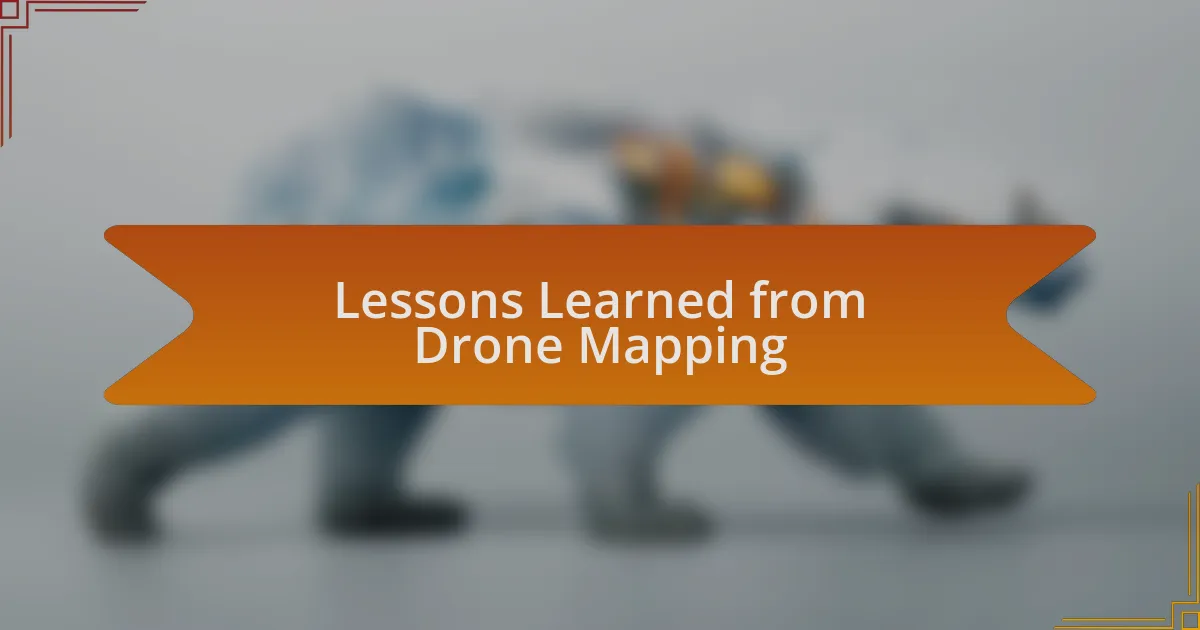
Lessons Learned from Drone Mapping
When I first started drone mapping, I was eager to capture as much as possible in one flight. However, I quickly learned that the best images often require extended periods of stillness and observation. I remember an instance when I hovered above a lush landscape, waiting for the right light to illuminate the textures below. That stillness taught me the importance of timing, and in those quiet moments, I developed a deeper connection with the environment.
There was a particular project where I aimed to map a vibrant coral reef. It was challenging work; not only did I face technical difficulties, but the ever-changing sea patterns tested my resolve. I found myself sitting in a boat, watching the waves and adjusting my strategy rather than rushing in. That experience truly highlighted how preparing and pacing oneself is essential in drone mapping—sometimes the best results come from simply observing and waiting for conditions to align.
I’ve also had the opportunity to document rural landscapes, where I discovered that patience often brought unexpected rewards. One day, while waiting at sunrise, I was captivated by the sight of farmers tending to their fields. I realized that capturing these human elements added depth to my maps. That taught me that patience in aerial photography is not just about the technical aspects; it’s also about patiently seeking the stories and connections hidden within each frame. What stories do you think your surroundings hold, waiting for you to uncover them?